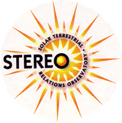STEREO LET Level 1 and Level 2 Data Documentation
LET Level 1 and Level 2 Data
The LET Level 1 and Level 2 data are energetic particle intensities (1/(cm^2 s sr MeV/nuc)) for 16 species, in ~12 energy-bins per species.
The highest time-resolution data provided by LET is 1 minute. On this website, we currently provide the 1-minute data (Level 1 data) in ASCII text files, with each file containing one day of data, for one species, for one spacecraft (ahead or behind).
We also provide 10-minute, hourly-averaged and daily-averaged data (Level 2 data) in ASCII text files, with each file containing one calendar year of data, for one species, for one spacecraft. For the 10-minute averages, we also provide files containing 1 month of data.
We also provide 27-day averages, in standard and summed energy bins
Each ASCII file begins with a header that provides version and other provenance information, and describes each data field.
The LET 1-minute data are also available in CDF format, from the STEREO IMPACT Data portal at Berkeley.
The LET data come in three "flavors": Standard, Summed, and Sectored.
- Standard: Includes intensities for all the species/energy combinations defined
in the LET onboard software. Some of the species/energy combinations may be set to FILL-DATA, as
described in the release-notes/caveats.
Full listing of Standard species/energy-bins. - Summed: For each species the standard energy-bins are combined into wider energy-bins.
These wider bins have better statistics, and are common to most/all of the species
identified by LET. These Summed data are useful for calculating element ratios, and may be more
useful that the Standard data during quiet periods.
Full listing of Summed species/energy-bins. - Sectored:The LET onboard software sorts events into 16 look-directions, or sectors
(See figure), 8 per side. Both the
front (A-side) and rear (B-side) include particles from a 129deg x 29deg Field
of View (FOV) with the 129deg fan looking along the ecliptic plane.
The center of the A-side 129deg fan points at an angle that is 45deg from the Sun-spacecraft line. When the spacecraft is in its nominal roll orientation, this direction is 45deg west of the Sun (along the average Parker Spiral direction at 1 AU), i.e., in the [-R,+T] direction. Since July 2015, after solar conjunction, the two STEREO spacecraft have been rolled 180deg about the Sun-spacecraft line in order to allow the high gain antenna to remain pointing at Earth. Consequently, the center of the A-side fan now points 45deg east of the Sun, in the [-R,-T] direction (i.e., perpendicular to the average Parker Spiral direction). Except for brief periods when the spacecraft is rolled for SECCHI or MAG calibrations, this will remain the case until the spacecraft passes by Earth again in 2023. Periods of off-nominal roll angles (including those at the beginning of the mission, when the spacecraft were still in Earth orbit) are shown in these spacecraft roll angle plots.
Note: on Nov 22, 2010, the definition of some of the sectored rates was changed.
Please review the following documents before using the LET sectored data:- Full listing of Sectored species/energy-bins.
- Mounting and orientation of LET on the STEREO spacecraft. - includes coordinate-transformation information.
- LET Geometry Factors - including sectored geometry factors as a function of dynamic-threshold state.
- STEREO attitude and orbit data
During large SEP events, the geometry factors for H and He depend upon the
dynamic-threshold state of the instrument. This dynamic-threshold state is
included in each record in the LET data, and is used in the Level 1 data
processing to select the appropriate geometry factor when computing the
intensities.
LET Instrument Description
The Low Energy Telescope (LET) is one of four sensors that make up the Solar
Energetic Particle (SEP) instrument of the
IMPACT investigation for NASA's
STEREO mission. The LET is designed to measure the elemental composition,
energy spectra, angular distributions, and arrival times of H to Ni ions over
the energy range from ~3 to ~30 MeV/nucleon. It will also identify the rare
isotope 3He and trans-iron nuclei with 30 <= Z <= 83. The SEP measurements
from the two STEREO spacecraft will be combined with data from ACE and other
1-AU spacecraft to provide multipoint investigations of the energetic
particles that result from interplanetary shocks driven by coronal mass
ejections (CMEs) and from solar flare events. The multipoint in situ
observations of SEPs and solar-wind plasma will complement STEREO images of
CMEs in order to investigate their role in space weather. Each LET instrument
includes a sensor system made up of an array of 14 solid-state detectors
composed of 54 segments that are individually analyzed by custom Pulse Height
Analysis System Integrated Circuits (PHASIC). The signals from four PHASIC
chips in each LET are used by a Minimal Instruction Set Computer (MISC) to
provide on-board particle identification of a dozen species in ~12 energy
intervals at event rates of ~1000 events/sec. An additional control unit,
called SEP Central, gathers data from the four SEP sensors, controls the SEP
bias supply, and manages the interfaces to the sensors and the SEP interface
to the IMPACT Data Processing Unit (IDPU).
The LET design, calibration and operation is described in detail in a Space Science Reviews paper by Mewaldt et al. (2008).
Instrument cross-section diagram
Figure showing LET species/energy-range coverage
LET Geometry Factors - including sectored factors
Mounting and orientation of LET on the STEREO spacecraft
Other potentially useful LET and SEP-suite docs
